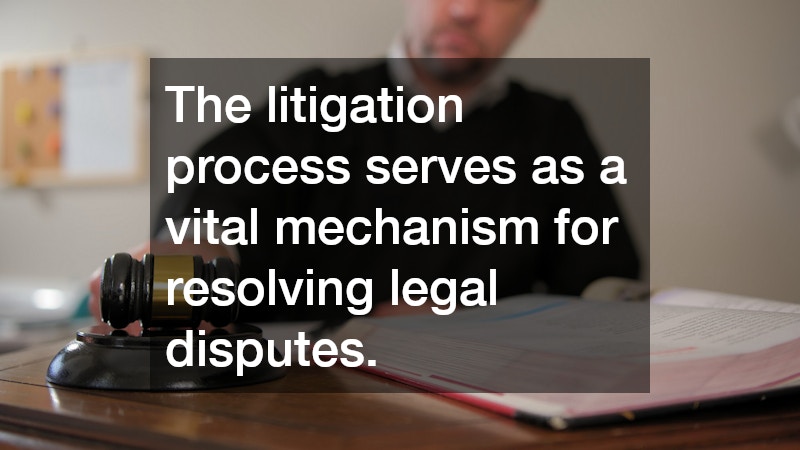In the ever-evolving landscape of legal practice, comprehending the intricacies of the litigation process is crucial for practitioners. As the cornerstone of dispute resolution, litigation serves as the framework through which legal conflicts are addressed and resolved. The litigation process encompasses a series of structured steps designed to provide a fair and just resolution to legal disputes.
In this article, we will delve into an in-depth exploration of the key stages of the litigation process, offering legal practitioners valuable insights to navigate these complexities effectively. By understanding each component, practitioners will be better equipped to advocate for their clients with precision and expertise.
At its core, the litigation process involves a sequence of structured legal procedures. These procedures are meticulously designed to ensure that both parties have an equitable opportunity to present their case. From the initiation of a lawsuit to the final resolution, each phase plays a pivotal role in determining the outcome. Legal practitioners must be well-versed in these stages to provide competent representation and protect their clients’ interests. Moreover, a profound understanding of the litigation process is instrumental in formulating strategic approaches that align with the unique nuances of each case.
Pre-Litigation and Filing the Lawsuit
The initial phase of the litigation process involves pre-litigation activities, which lay the foundation for the case. During this stage, legal practitioners engage in critical tasks such as conducting client interviews, gathering evidence, and evaluating the merits of the case. The objective is to ascertain whether litigation is the appropriate course of action. This assessment is followed by the drafting and filing of the complaint, marking the official commencement of the lawsuit. The complaint outlines the plaintiff’s allegations and the legal grounds for the claim, serving as a formal request for judicial intervention.
An essential aspect of pre-litigation involves formulating a strategic approach that aligns with the client’s objectives. Practitioners must evaluate various factors, including the strength of the evidence, potential defenses, and the desired outcome. Thorough preparation during this stage can significantly influence the trajectory of the case. Once the complaint is filed, it is imperative to ensure that service of process is properly executed. This step is crucial, as it provides the defendant with formal notice of the litigation, safeguarding their right to due process.
Discovery and Pre-Trial Proceedings
Following the filing of the complaint, the discovery phase begins, serving as a critical component of the litigation process. Discovery is a mechanism that allows both parties to obtain relevant information and evidence from one another. This reciprocal exchange ensures transparency and enables each side to assess the strengths and weaknesses of their case. Common discovery tools include interrogatories, requests for production of documents, and depositions. Legal practitioners must be adept at leveraging these tools to gather information that supports their client’s position.
Pre-trial proceedings encompass a range of activities that set the stage for trial. These proceedings include hearings on motions, such as motions to dismiss or summary judgment, which can potentially resolve the case without a full trial. As such, it is essential for practitioners to craft well-reasoned arguments and present compelling evidence in support of their motions. Additionally, pre-trial conferences offer an opportunity for the parties to discuss the possibility of settlement. During these conferences, the court may facilitate negotiation in an attempt to resolve the matter amicably.
Trial and Post-Trial Proceedings
The trial stage is the culmination of the litigation process, where the parties present their arguments and evidence before a judge or jury. During trial, legal practitioners engage in meticulous preparation to deliver compelling opening and closing statements, examine witnesses, and present relevant exhibits. The litigation process reaches its zenith as practitioners advocate zealously on behalf of their clients. Success at trial requires a mastery of courtroom procedures, persuasive communication skills, and the ability to anticipate and counter opposing arguments.
Following the conclusion of the trial, post-trial proceedings may ensue, depending on the outcome. If the verdict is unfavourable, parties may explore options for appeal, challenging legal errors or seeking a review of the decision. Legal practitioners must evaluate the merits of an appeal and advise clients accordingly. Additionally, post-trial motions, such as motions for a new trial or for judgment notwithstanding the verdict, may be filed to seek further judicial intervention. These motions necessitate a comprehensive understanding of procedural rules and a strategic approach to advocacy.
Ultimately, the litigation process serves as a vital mechanism for resolving legal disputes, reinforcing the integrity of the legal system. Legal practitioners who exhibit proficiency in navigating this process play a fundamental role in advancing the pursuit of justice. As the legal landscape continues to evolve, practitioners must remain vigilant, adapting to new challenges and emerging trends. By doing so, they will not only contribute to the effective resolution of conflicts but also uphold the ideals of justice that underpin the legal profession. With a steadfast commitment to understanding and executing the litigation process, practitioners stand as champions of justice and advocates for their clients.
